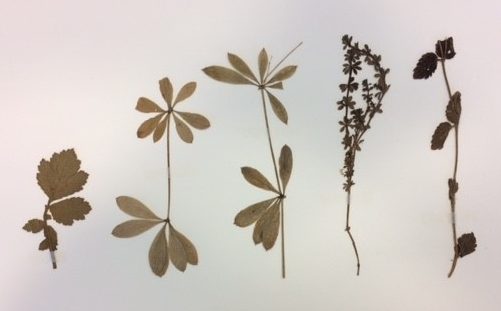Conserving Edward Thomas’ Herbarium
24 October 2017
This post was originally written for the Cardiff University Special Collections and Archives blog. They have kindly allowed us to share their post here on our blog as well.
Leaves and flowers are generally removed from archives or books collection, as this organic material encourages pests, stains paper and can be poisonous, but when they have been pressed between pages for over a century, a different approach must be considered. Herbarium collections can add value and depth to an archive, and can offer a new angle for research. Earlier this year, a herbarium collection of about 20 different plants was found within the Special Collections’ Edward Thomas archive. These pressed flowers and leaves were found in three different notebooks dated between 1895-1896, which had been selected to be conserved thanks to generous funding by the NMCT. Nature, and specifically the Welsh countryside, is known to be a major inspiration for Edward Thomas’ works.
Part of the conservation activity funded by the NMCT grant included hinging the pressed plants with Japanese tissue to micro-chamber board, and encapsulating it, which would give support to the plant and protect it from exterior factors – mainly humidity and pests. Part of any conservator’s job is to do huge amounts of research. I was very curious about herbariums, and came across many research papers warning of previous treatments that could be hazardous.
Previous treatments
It was common practice, as recently as the 1980s, to treat herbariums with mercury chloride as a disinfectant against pests. It would be applied in one of two ways – soaked, or brushed on with ethanol. Mercury chloride, although once used against syphilis, is extremely poisonous. It can reduce into metallic mercury, which is liquid at room temperature and can vaporise. Mercury vapour can build up to harmful levels when samples of treated plants are kept in boxes or between pages, and the vapour is highly poisonous if inhaled. The World Health Organisation has classified mercury as “extremely hazardous Class 1A”. The emission of mercury vapour from herbariums can be an occupational health hazard for collection workers and researchers.
How do you know if the collection has been previously treated with mercury chloride?
There are a few ways to test for the presence of mercury chloride. Working in collaboration between Glamorgan Archives, Special Collections and Archives, and Cardiff University Conservation Department, we decided to use the Conservation department’s portable XRF. An XRF is an X-ray Fluorescent Spectrometer that determines what elements are present. It is a non-invasive technique, which is appropriate for rare collections and heritage objects.
To explain briefly, the X-ray beam affects the atom, which releases a burst of energy that is characteristic of a specific element. This produces a graph which can be analysed. Under the guidance of PhD candidate Chris Wilkins, we tested all the samples. Luckily none of the samples came up with a positive reading for mercury chloride. We also looked for arsenic and lead, other common historical biocides that are classified as hazardous. All of the readings indicated that mercury, arsenic and lead were absent.
Benefits of testing
Knowing that the herbarium has been tested ensures a safe working environment for archive workers and researchers. It also informs the storage plan for the herbarium. If samples were contaminated, then a form of ventilation would be required to ensure vapour ratios are within UK health and safety regulations. Testing the samples has improved the collection’s accessibility for readers and researchers, and allows further information to be uncovered. Sampling DNA, or categorising the plants would give us a fuller image of Edward Thomas’ landscape in the late 1800s.
The herbarium has been encapsulated, and remains between the pages of Edward Thomas notebooks. If you are interested in Edward Thomas’ notes, poetry or the plants that took his interest, they can all be found and explored safely in Special Collections and Archives.
Pam has been working on the Edward Thomas Conservation project as a student conservator thanks to the generous support of the National Manuscript Conservation Trust.
- March 2024 (1)
- December 2023 (1)
- November 2023 (2)
- March 2023 (2)
- January 2023 (6)
- November 2022 (1)
- October 2022 (1)
- June 2022 (6)
- January 2022 (8)
- March 2021 (2)
- January 2021 (3)
- June 2020 (1)
- May 2020 (1)
- April 2020 (1)
- March 2020 (4)
- February 2020 (3)
- January 2020 (5)
- November 2019 (1)
- October 2019 (1)
- June 2019 (1)
- April 2019 (2)
- March 2019 (1)
- January 2019 (1)
- August 2018 (2)
- July 2018 (5)
- June 2018 (2)
- May 2018 (3)
- March 2018 (1)
- February 2018 (3)
- January 2018 (1)
- December 2017 (1)
- October 2017 (4)
- September 2017 (1)
- August 2017 (2)
- July 2017 (1)
- June 2017 (3)
- May 2017 (1)
- March 2017 (2)
- February 2017 (1)
- January 2017 (5)
- December 2016 (2)
- November 2016 (2)
- June 2016 (1)
- March 2016 (1)
- December 2015 (1)
- July 2014 (1)
- February 2014 (1)
- January 2014 (4)



